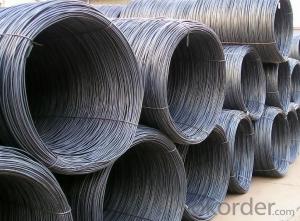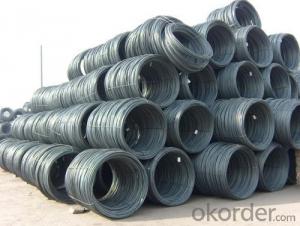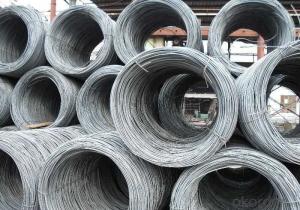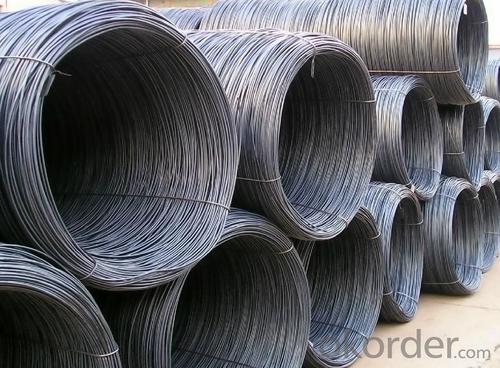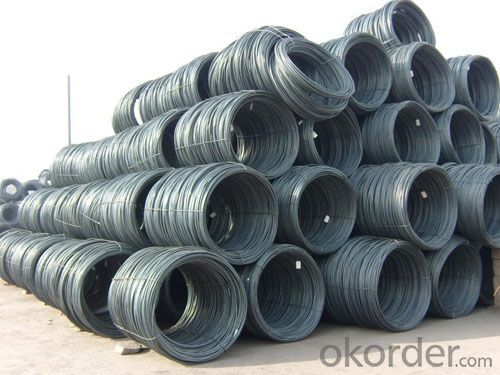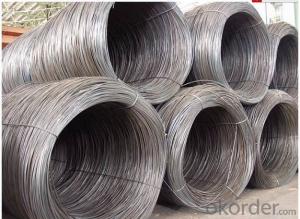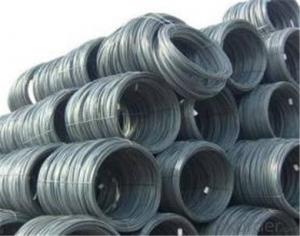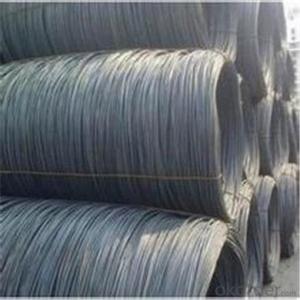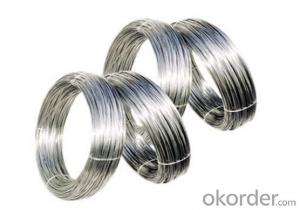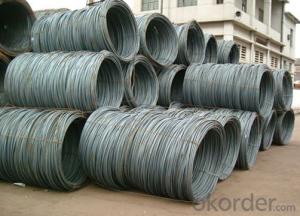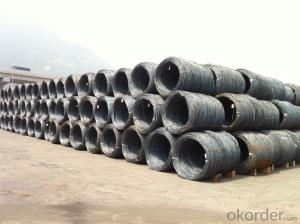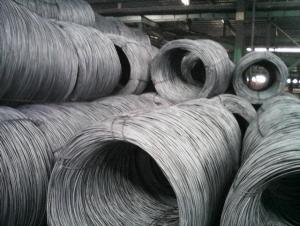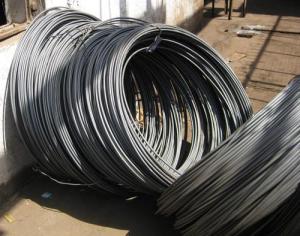High Quality Steel Wire Rod SAE1008 5.5mm
- Loading Port:
- Tianjin
- Payment Terms:
- TT or LC
- Min Order Qty:
- 50 m.t
- Supply Capability:
- 10000 m.t/month
OKorder Service Pledge
OKorder Financial Service
You Might Also Like
High Quality Steel Wire Rod SAE1008 5.5mm
Product Description:
Specifications of Wire Rod SAE1008:
Grade: SAE1008 Standard: ASTM
Diameter: 5.5mm
Alloy or Not: Alloy
Technique: Hot Rolled Place of Origin: China Mainland
Chemical Composition:
Please kindly find our chemistry of our material based on SAE1008 as below for your reference:
Grade | Chemical Composition (%) | |||||
C | Mn | S | P | Si | ||
SAE1008 | 0.10max | 0.32max | 0.045max | 0.040max | 0.30max | |
Mechanical properties | ||||||
Yield strength(N/mm2) | Tensile strength(N/mm2) | Elongation (%) | ||||
≥195 | 350-380 | ≥32 | ||||
Usage and Applications of High Quality Steel Wire Rod SAE1008 5.5mm:
After hot-rolled the products shaped into coil and delivery as finished product, including round, square,rectangular, hexagonal and so on. Since most of the products are round, it is generally called wire rod. Carbon steel wire rod is widely used in construction and manufacturing. Carbon steel wire rod is mainly used for reinforcement of reinforced concrete and welded structure or reprocessed (roberts , nail, etc.) materials, especially used to produce wire drawing, welding electrode, nails, spring, electronic, precise machinery parts and so on.
Packaging & Delivery of High Quality Steel Wire Rod SAE1008 5.5mm:
Packaging Detail: products are packed in coil and then shipped by container or bulk vessel
Each coil weight: About 2.05MT
Delivery Detail: within 45 days after received deposit or LC.
Label: to be specified by customer, generally, each bundle has 1-2 labels
Trade terms: FOB, CFR, CIF
FAQ:
Q1: Why buy Materials & Equipment from OKorder.com?
A1: All products offered byOKorder.com are carefully selected from China's most reliable manufacturing enterprises. Through its ISO certifications, OKorder.com adheres to the highest standards and a commitment to supply chain safety and customer satisfaction.
Q2: How do we guarantee the quality of our products?
A2: We have established an advanced quality management system which conducts strict quality tests at every step, from raw materials to the final product. At the same time, we provide extensive follow-up service assurances as required.
Q3: How soon can we receive the product after purchase?
A3: Within three days of placing an order, we will arrange production. The shipping date is dependent upon the quatity, how many sizes you want and the plan of production, but is typically 1 month to 2 month days from the beginning of production.
Images of High Quality Steel Wire Rod SAE1008 5.5mm:
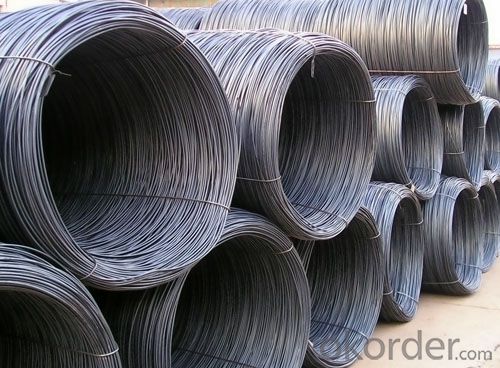
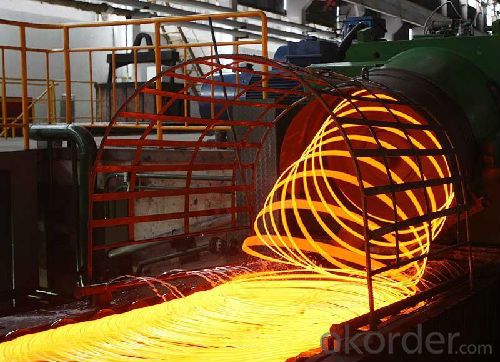
*If you would like to get our price, please inform us the size, standard/material and quantity. Thank you very much for your attention.
- Q: How does the fatigue strength of steel wire rod vary with different heat treatment processes?
- The fatigue strength of steel wire rod can vary significantly depending on the methods of heat treatment employed. Heat treatment involves subjecting the steel wire rod to specific heating and cooling processes in order to change its microstructure and mechanical properties. One commonly used heat treatment process to improve the fatigue strength of steel wire rod is quenching and tempering. This process includes heating the wire rod to a high temperature and then rapidly cooling it (quenching) to achieve a hardened microstructure. This leads to an increase in the fatigue strength of the wire rod because the hardened structure provides better resistance against fatigue failure. The subsequent tempering process involves reheating the wire rod to a lower temperature and slowly cooling it, which helps to relieve internal stresses and improve the toughness of the wire rod while maintaining an optimum balance of strength and ductility. On the other hand, if the steel wire rod undergoes a heat treatment process at a lower temperature, such as annealing, the fatigue strength may be reduced. Annealing involves heating the wire rod to a specific temperature and allowing it to cool slowly, often in a controlled atmosphere. This process is used to soften the wire rod, relieve internal stresses, and improve its machinability and formability. However, the resulting softer microstructure may cause a decrease in fatigue strength compared to quenched and tempered wire rod. In conclusion, the fatigue strength of steel wire rod can be improved through heat treatment processes like quenching and tempering, which lead to a hardened microstructure. Conversely, heat treatment processes like annealing can decrease the fatigue strength by producing a softer microstructure. Therefore, the selection of heat treatment processes is crucial in determining the fatigue strength of steel wire rod.
- Q: How does steel wire rod compare to other materials for wire production?
- Steel wire rod is widely regarded as one of the superior materials for wire production due to its exceptional strength, durability, and versatility. Compared to other materials such as copper, aluminum, and brass, steel wire rod offers several distinct advantages. Firstly, steel wire rod exhibits superior tensile strength, making it highly resistant to breakage or deformation under heavy loads or extreme conditions. This strength is crucial in applications where wire is used for supporting structures or carrying heavy loads, ensuring the wire remains intact and reliable. Secondly, steel wire rod has excellent corrosion resistance properties, especially when compared to materials like copper or brass. This makes it an ideal choice for wire production in outdoor or high-moisture environments, where protection against rust and degradation is essential for the longevity and performance of the wire. Additionally, steel wire rod is known for its exceptional ductility, allowing it to be easily shaped and formed into various wire types and sizes. This flexibility makes it suitable for a wide range of applications, from electrical wiring to fencing, automotive components, and construction materials. Furthermore, steel wire rod is relatively cost-effective compared to materials like copper, making it a more economical choice for wire production without compromising on quality or performance. Its widespread availability and production efficiency contribute to its affordability. In summary, steel wire rod surpasses other materials in wire production due to its exceptional strength, corrosion resistance, ductility, and cost-effectiveness. Its versatile nature and reliability make it an ideal choice for a wide range of applications, making steel wire rod the preferred material in the wire industry.
- Q: How is steel wire rod used in the manufacturing of wire grilles?
- Steel wire rod is used in the manufacturing of wire grilles as the main material for the wires that form the grilles. The wire rod is first drawn into the desired thickness and shape and then woven or welded together to create the wire grille. The strength and durability of the steel wire rod make it ideal for withstanding the rigors of everyday use, providing stability and security to the wire grilles.
- Q: How is steel wire rod used in the manufacturing of wire for mesh used in agriculture?
- Steel wire rods are used in the manufacturing of wire for mesh used in agriculture as they serve as the raw material for the production process. These rods are first drawn through a series of dies to reduce their diameter and increase their length, forming wire strands. These strands are then woven or welded to create mesh panels that are highly durable and provide structural support for various agricultural applications such as fencing, animal enclosures, and crop protection.
- Q: How is steel wire rod used in the production of wire mesh for mining and quarrying applications?
- Steel wire rod is used in the production of wire mesh for mining and quarrying applications by being drawn into thin wires and then woven or welded together to create a strong and durable mesh structure. This mesh is then used to reinforce tunnels, protect equipment, and provide safety barriers in mining and quarrying operations.
- Q: What are the main factors influencing the choice of steel wire rod quality standards?
- The main factors influencing the choice of steel wire rod quality standards include the intended application or use of the wire rod, industry regulations and standards, customer requirements, and the overall quality and performance expectations of the end product. Additionally, factors such as cost, availability, and the reputation of the supplier or manufacturer may also play a role in determining the standards for steel wire rod quality.
- Q: How is steel wire rod used in the manufacturing of wire forms for security fencing?
- Steel wire rod is an essential component in the manufacturing of wire forms for security fencing. It serves as the main raw material for creating durable and strong wire fences. Firstly, steel wire rod is processed through a series of mechanical and chemical treatments to enhance its properties, such as strength, flexibility, and corrosion resistance. This ensures that the wire forms produced from it can withstand harsh weather conditions, physical impact, and attempts of breaching. Once the steel wire rod is prepared, it is then formed into various shapes and sizes to fit the specific requirements of security fencing. This can include straight wires, coils, or even intricate designs like barbed wire or razor wire, depending on the level of security desired. The wire forms are then assembled and connected to create the desired security fence structure. This can involve weaving, welding, or fastening the wire forms together using specialized tools and techniques. The strength and durability of the steel wire rod ensures that the fence will maintain its structural integrity and resist any attempts to cut, break, or tamper with it. Moreover, steel wire rod can also be galvanized or coated with protective layers to enhance its resistance to corrosion, rust, and other environmental factors. This further increases the lifespan of the security fence and reduces the need for frequent maintenance or replacement. In summary, steel wire rod plays a crucial role in the manufacturing of wire forms for security fencing. Its strength, durability, and resistance to corrosion make it an ideal material for creating robust and long-lasting fences that provide effective security measures.
- Q: How does the dimensional accuracy of steel wire rod vary with different heat treatment processes?
- The dimensional accuracy of steel wire rod can vary with different heat treatment processes. Heat treatment involves subjecting the steel wire rod to controlled heating and cooling processes to alter its physical and mechanical properties. One common heat treatment process for steel wire rod is annealing. During annealing, the wire rod is heated to a specific temperature and then slowly cooled. This process helps to relieve internal stresses, improve ductility, and refine the grain structure of the steel. In terms of dimensional accuracy, annealing can help reduce internal stresses that may cause distortion or warping in the wire rod, resulting in improved dimensional stability. Another heat treatment process is quenching and tempering. Quenching involves rapidly cooling the wire rod after heating it to a high temperature, typically in a liquid such as oil or water. This rapid cooling process hardens the steel, making it stronger but also more brittle. To improve the toughness and reduce the brittleness, the wire rod is then tempered by reheating it to a lower temperature and then slowly cooling it. The dimensional accuracy may be affected during the quenching process due to rapid cooling, which can cause distortion or warping. However, tempering helps to reduce the brittleness and minimize the distortion, resulting in improved dimensional accuracy. Furthermore, other heat treatment processes such as normalizing and stress relieving can also influence the dimensional accuracy of steel wire rod. Normalizing involves heating the wire rod to a specific temperature and then allowing it to cool in still air. This process helps to refine the grain structure and improve the mechanical properties of the steel. Stress relieving, on the other hand, involves heating the wire rod to a temperature below the critical range and then slowly cooling it, which helps to reduce internal stresses. Both normalizing and stress relieving can contribute to improved dimensional accuracy by minimizing distortions or warping. In summary, the dimensional accuracy of steel wire rod can vary with different heat treatment processes. Annealing, quenching and tempering, normalizing, and stress relieving are some of the commonly used heat treatment processes that can impact the dimensional accuracy. The choice of the heat treatment process should be carefully considered to achieve the desired dimensional accuracy while also meeting the required mechanical properties of the steel wire rod.
- Q: How is the surface cleanliness of steel wire rod tested?
- To ensure the quality and suitability of steel wire rod for further processing or use, a variety of methods are typically employed to test its surface cleanliness. One commonly utilized technique involves visually inspecting the wire rod for any visible contaminants or defects. Another method entails closely examining the wire rod's surface using a microscope or magnifying glass. This more detailed inspection allows for the detection of smaller particles or defects that may not be noticeable to the naked eye. Aside from visual inspection, other techniques such as magnetic particle inspection (MPI) or dye penetrant inspection (DPI) may be utilized. MPI involves applying a magnetic field and a magnetic particle solution to the wire rod, revealing any surface defects or cracks. DPI, on the other hand, entails applying colored dye to the wire rod's surface, which seeps into any cracks or defects, making them more visible. Furthermore, non-destructive testing techniques such as ultrasonic testing or eddy current testing can also be used to measure surface cleanliness. Ultrasonic testing involves transmitting high-frequency sound waves through the wire rod, with any irregularities or contaminants reflecting these waves differently and thus enabling their detection. Eddy current testing, on the other hand, utilizes electromagnetic induction to identify surface defects or contaminants by detecting changes in the wire rod's electrical conductivity. In summary, a combination of visual inspection, microscopic examination, and various non-destructive testing techniques are employed to test the surface cleanliness of steel wire rod. These methods help identify any surface defects, contaminants, or irregularities that may impact the wire rod's performance or integrity.
- Q: What are the different types of wire products that can be made from steel wire rod?
- Steel wire rods can be transformed into a wide range of wire products, depending on their intended use and specific requirements. Some examples of these wire products include: 1. Wire mesh: Wire mesh is a versatile material made from steel wire rods that finds applications in fencing, construction, and filtration. Depending on the desired strength and durability, wire mesh can be woven or welded. 2. Wire ropes: Wire ropes, which are strong and flexible cables used for lifting, towing, and securing heavy objects, are commonly manufactured using steel wire rods. They are extensively used in industries like construction, mining, and maritime. 3. Springs: Specific mechanical properties and high tensile strength of steel wire rods make them suitable for manufacturing springs. Springs are widely used in industries such as automotive, furniture, and electronics to provide elasticity and support. 4. Fasteners: Steel wire rods can be shaped into screws, nails, and bolts, serving as essential fasteners in construction, manufacturing, and other industries. These fasteners ensure secure and reliable connections. 5. Wire forms: By bending, twisting, and shaping steel wire rods, wire forms like baskets, shelving, and display racks are created. Wire forms provide structural support and organization in various settings. 6. Wire reinforcements: Steel wire rods are commonly used as reinforcements in concrete structures like buildings, bridges, and highways. These reinforcements enhance the strength and durability of the concrete, ensuring structural integrity. 7. Wire connectors: Steel wire rods are utilized in the manufacturing of wire connectors, which are essential for joining and connecting electrical wires. These connectors guarantee efficient power transmission through secure and reliable electrical connections. 8. Wire brushes: Steel wire rods can be twisted and arranged to create wire brushes used in cleaning and polishing applications. Industries like automotive, metalworking, and janitorial services commonly use wire brushes. Overall, steel wire rods offer versatility and strength, enabling the production of various wire products that cater to diverse industries and applications.
Send your message to us
High Quality Steel Wire Rod SAE1008 5.5mm
- Loading Port:
- Tianjin
- Payment Terms:
- TT or LC
- Min Order Qty:
- 50 m.t
- Supply Capability:
- 10000 m.t/month
OKorder Service Pledge
OKorder Financial Service
Similar products
Hot products
Hot Searches
Related keywords
